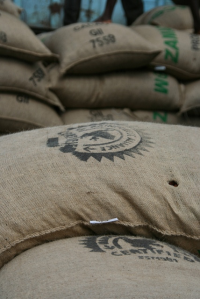![00636_hd[1]](https://whydowelovechocolate.files.wordpress.com/2013/06/00636_hd1.jpg?w=232&h=310) With plant material it is crucial to determine per situation what the best plant variety is and to make sure that it is locally available. The problem is that there is a huge gap between science and practice: scientists are focused on publishing fundamental research and farmers use whatever is available locally. The crux is to apply scientific knowledge locally.
With plant material it is crucial to determine per situation what the best plant variety is and to make sure that it is locally available. The problem is that there is a huge gap between science and practice: scientists are focused on publishing fundamental research and farmers use whatever is available locally. The crux is to apply scientific knowledge locally.
Cocoa production can be increased threefold by using sustainable agricultural techniques, new plant material, and fertilizer. The availability of knowledge on these techniques and the appropriate inputs is generally not perceived as a problem (but requires ongoing investments). A lot is already known and investments are being made in technical research on combating pests and diseases, new plant material, and other topics. This research is mainly conducted outside the Netherlands, by privat R&D departements, specialized cocoa research centres, and universities. Often they work together in the developments of this – more technical- scientific knowledge. The key challenge is how to bridge the gap between this type of knowledge and the materials and knowledge that farmers use on the ground. There is a serious need to make science applicable in local circumstances, and thus to make it more useful for farmers.
Training is essential for reaching out to farmers. The central rationale, shared by the different actors involved in mainstreaming sustainable cocoa, is that farmer training increases farmer productivity levels and quality of the produce, ultimately increasing farmer income. It is expected that this additional income will be invested in the well-being of their family members, their cocoa farms, and their communities. This should be lead to the desirable future outcome of cocoa farming becoming an honourable profession, which strongly appeals to the young. Clearly training is an important element, but providing training to millions of farmers and workers is not an easy task. Several key challenges in training smallholders are presented in the next lines: First of all, many farmers lack primary school education so a training program should be practical and connect farmers’ experience and capacities. Second, the infrastructure to train farmers is either lacking or underdeveloped in many cocoa producing countries. Third, local extension services are in many places underdeveloped, which is linked to the limited investment in the cocoa sector and infrastructures from the side of the goverment in many cocoa producing countries.
In responce to these difficulties, the cocoa industry and their governmental and civil society partners have decided to organise – in both consumer and producer countries – the farmer training by themselves. The participatory training model that these partners use is the Farmer Field School (FFS) approach. In these schools farmers include pruning, control of pests and diseases, harvesting, fermenting, drying and storing cocoa beans. The Sustainable Tree Crop Program (STCP) – and international public-privat partnership between industry, producers, reasearchers, goverment agencies, public sector institutions and conservations groups – has been a major player in setting-up these schools in West-Africa. The intergovernmental organisation CABI, which opened an office in the Netherlands, has played an important role in developing the curriculum of these Farmer Field School for the STCP.
Farmer Field Schools are intensive and expensive courses that quickly educate untrained farmers to improve and expand their production as soon as possible. This is an emergency measure and not viable in the long term. Therefore, more sustainable ways of training farmers have to be set up, together with goverments and research institutes. This could be done by linking up with existing structures such as extension services, but alternative ways also have to be explored.
Its all about changing the farmrs’ behaviour. Therefore you need training, just as you need inputs, financing, and market opportunities. Effective training, to get people to understand what they should do, has to be done at lowest possible costs in order to be able to reach the mainstream. There are different models with which they are experimenthing; Farmer Field School is one of them. FFS is an expensive but effective manner to train some farmers, but the knowledge that some acquire does not sufficiently trickle down to other. How do you get adults to learn, that’s the challenge.
Alternative and additional forms of training are necessary, not only because it is necessary to develop cheaper alternatives but also because of the necessit to increase knowledge dissemination among farmers. Although farmers that receive the FFS training have to commit themselves to train three colleagues, in practice this knowledge dissemination is limited. There are a variety of potential explanations: the farmers have limited capacities as trainers; they do not share knowledge on purpose to retain an advantage over their neighbours; their neighbours could be physically located at a prohibitive distance; and other barriers.
To overcome this problem partners in the certification scheme are investing in an additional training model called Training of Trainers (ToT). Farmers that show enthusiasm and progress in acquiring new skills are offered the opportunity to become trainers themselves. They have to follow and additional course and if they pass they receive a certificate that allows them to train other farmers.
In order for farmers to receive training they need to be organised. Moreover, farmer organisations are the primary entities that receive certifications. Farmer organisations are able to distribute goods (plant material, fertilizer) and services (training, credit) among their members and act as farmers representatives. Thus organisations have the potential to provide not only economic benefits but also empower farmers. Organisation farmers offers advantages also to industry, by providing support for the certification and auditing process, and by providing a distribution mechanism for inputs, training and finance.
There are many different types of farmer organisations. There are small groups of farmers that organise on an informal basis to collectively transport cocoa beans. On the other hand, there are huge national associations, which even have the power to influence national policies. One of the most recognised form of farmer organisation is the cooperative. In many developing counie coopeive wee ceed by govements and consequence wee politicised. Because of past negative experiences, many farmers are suspicious of the cooperative movement and choose not to organise in a formal way.
This lack of trust and the additional incentives that are required make it very difficult to organise a group of farmers in practise. This effort is further complicated by the fact that organisations that are founded by external actors tend to set overly ambitions goals or scale up to rapidly. Sometimes the new organisation even conflicts with the existing structures already in place. Also, farmers do not necessarily see the benefits of becoming organised or have no trust. To successfully organise farmers requires providing them with clear incentives. There are also organisations that secure a cooperative status for financial reasons; they primarily use their front as a legal entity and thus do not represent farmer interests.
It is apparent that organising an increasing numbers of farmers is a serious challenge. The strategy of actors involved in UTZ Certified was to start with improving and expanding existing cooperatives. In the Ivory Coast, where UTZ started a piloting the certification scheme, it is expected that around 20% of the farmers can be easily included in existing organisations. These farmers live close to big towns and enjoy the benefits of good infrastructure. Improving the quality of existing farmer organisations – in order to shape them into a trustworthy business partner- is challenging because they have low management and
negotiation capacity and have little capital to invest in improving their capacities. To set up new cooperatives or other types of farmer organisation is extremely difficult and it is a serious challenge to reach and organise the overall majority of farmers.
next time: Other themes and some reflections.












